Silex Technology ETHBG EtherBridge User Manual
Silex Technology, Inc. EtherBridge Users Manual
Users Manual
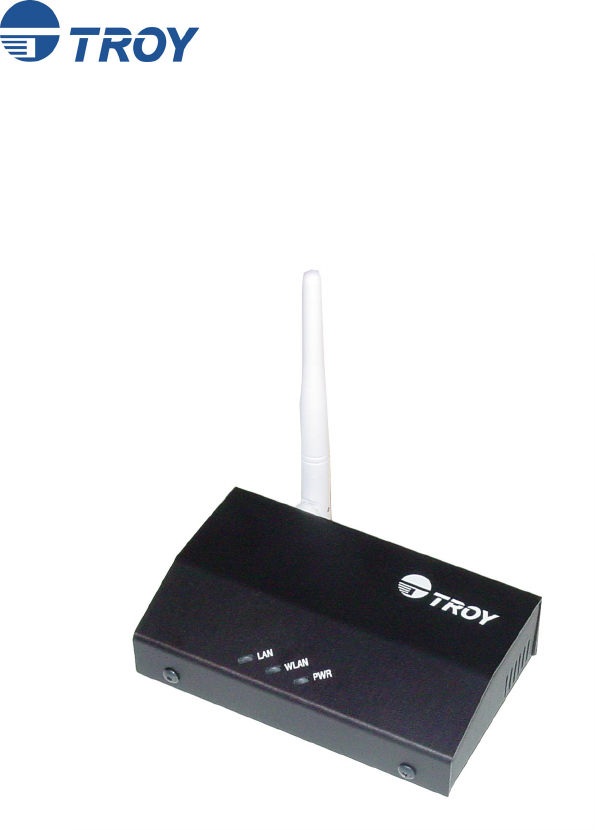
EtherBridge
Ethernet to Wireless Client Adapter
Installation and User’s Guide
Part Number 40177-100
Revision X1
Notice
TROY GROUP, INC. SPECIFICALLY DISCLAIMS THE IMPLIED WARRANTIES
OF MERCHANTABILITY AND FITNESS OF THIS PRODUCT FOR A
PARTICULAR PURPOSE. TROY shall not be liable for any errors contained in this
manual or for any damages resulting from loss of use, data profits, or any incidental or
consequential damages arising from the use of TROY products or services.
Warning
This equipment has been tested and found to comply with the limits for a Class B digital
device pursuant to Part 15 of FCC Rules. These limits are designed to provide reasonable
protection against such interference when operating in a commercial environment. This
equipment generates, uses, and can radiate radio frequency energy, and if not installed
and used in accordance with this guide, may cause harmful interference to radio
communications.
Operation of this equipment in a residential area is likely to cause interference in which
case the user, at his or her own expense, will be required to take whatever measures will
be required to correct the interference.
Trademarks
HP, HP/UX, LaserJet, DesignJet, DeskJet, PaintJet, JetDirect, and JetAdmin are
trademarks of Hewlett-Packard Company. DEC, DECserver, VMS, LAT, and ULTRIX
are trademarks of Digital Equipment Corporation. UNIX is a trademark of UNIX
Systems Laboratories. Ethernet is a trademark of Xerox Corporation. PostScript is a
trademark of Adobe Systems Incorporated. NetWare is a trademark of Novell, Inc.
Apple, Macintosh, LaserWriter, and AppleTalk are trademarks of Apple Computer, Inc.
IBM, LAN Server, and AIX are trademarks of International Business Machines
Corporation. LAN Manager, Windows, and MS-DOS are trademarks of Microsoft
Corporation. VINES is a trademark of Banyan Systems Inc. PrintKit is a trademark of
Northlake Software. QADD is a trademark of Network Compatibility Group. LAN
Attached and UNIX Printing for VINES is a trademark of Incognito Software Inc. XJet,
XMark, XConnect, and XAdmin are trademarks of TROY Group, Inc.
© Copyright 1992-2003 TROY Group, Inc. All rights reserved.
TROY Group, Inc.
2331 S. Pullman Street
Santa Ana, CA 92705
TEL: (949) 250-3280
FAX: (949) 250-8972
http://www.troygroup.com
sales@troygroup.com
© Copyright 2003 TROY Group, Inc.
Printed in the United States of America
October 1, 2003
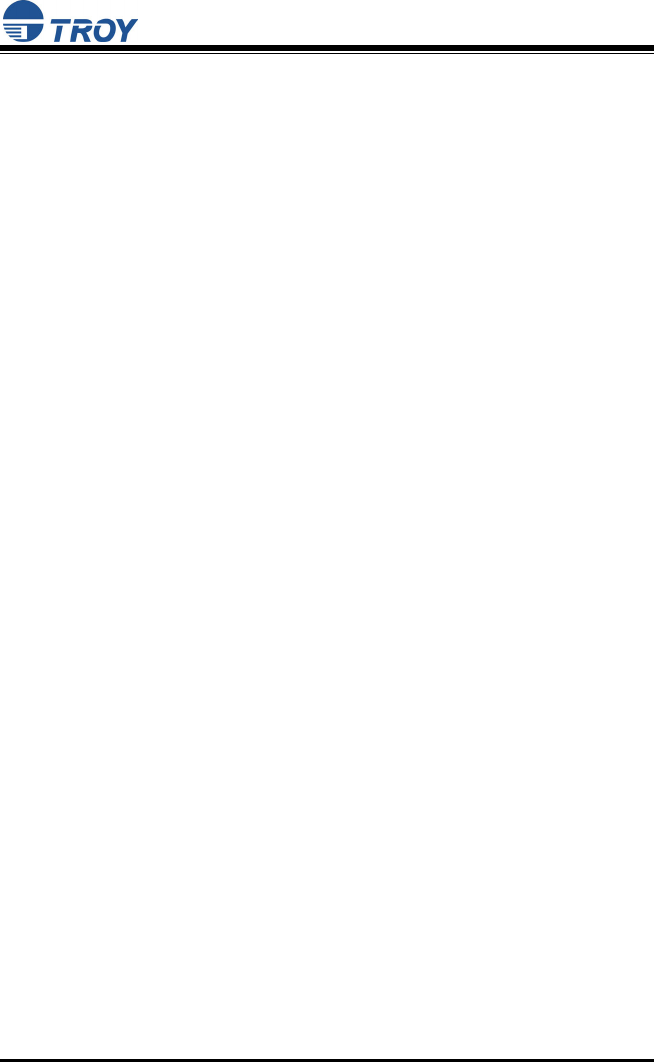
User’s Guide
Document #40177-100 Rev. X1
TABLE OF CONTENTS
Introduction...................................................................................1
Package Contents ........................................................................1
EtherBridge Adapter Components................................................2
Restoring Factory Default Settings...............................................2
LED Status Indicators...................................................................3
Installing the EtherBridge Adapter Hardware ...............................4
Configuring the EtherBridge Adapter............................................5
Installing the EtherBridge Utility....................................................5
EtherBridge Utility Menus .............................................................6
Web Browser Configuration........................................................10
Upgrading the EtherBridge Firmware .........................................11
Obtaining Technical Support ......................................................12
Returning Products.....................................................................13
Contacts......................................................................................14
Safety and Regulatory Notices ...................................................15
Declaration of Conformity ...........................................................17
Regulatory Information ...............................................................18
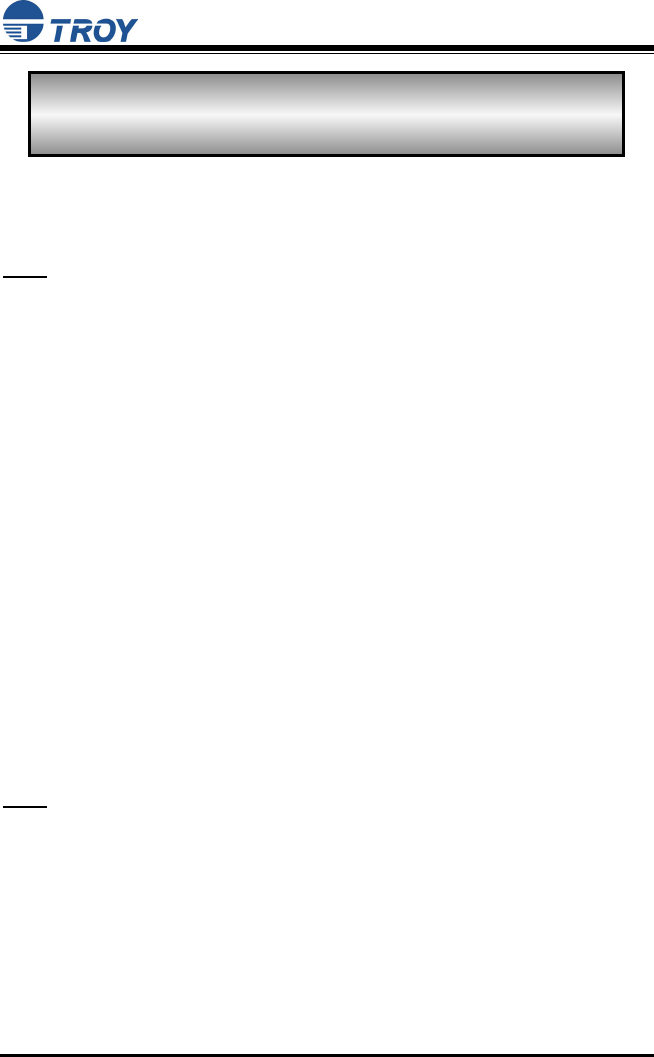
User’s Guide
Document #40177-100 Rev. X1 1
TROY Installation Instructions
(FOR USE WITH TROY ETHERBRIDGE ADAPTERS)
NOTE: This User’s Guide is available in other languages that can be printed from
the TROY EtherBridge Installation CD.
Introduction
The TROY EtherBridge Adapter is an Ethernet-to-wireless adapter that
converts any 10/100 Ethernet-enabled device to an 802.11b wireless
client device.
Package Contents
TROY EtherBridge Adapter
5-Volt Power Supply
Ethernet Crossover Cable
Universal Mounting Kit (for attaching the EtherBridge adapter to
a convenient location)
Desktop Mounting kit (for placing the EtherBridge adapter on a
desktop surface)
User’s Guide (This booklet)
TROY EtherBridge Installation CD
NOTE: If any of the above items are missing or damaged, contact TROY.
READ ME FIRST

TROY Group, Inc.
2
EtherBridge Adapter Components
Power Connector – The power supply cable plugs into this
connector.
LED Status Indicators – used to indicate the operational status of
the EtherBridge adapter. Refer to the table below for detailed LED
status light descriptions.
LAN Port – used for connecting the EtherBridge adapter to any
10baseT or 100baseTX Ethernet connection (an Ethernet card,
hub, router, or other wired access point) for network access. You
must use the included Ethernet crossover cable (or any other
crossover cable) when you directly connect two devices (such as a
PC, printer, or other Ethernet-enabled device) without the use of a
hub or switch.
Reset Button – used to restore the EtherBridge adapter to factory
default settings.
Restoring Factory Default Settings
The TROY EtherBridge Adapter can be reset to factory default settings
by performing the following steps:
1. Disconnect power from the EtherBridge Adapter. Press and hold the
reset button for three seconds while reapplying power to the device.
2. Release the reset button as soon as the WLAN LED is blinking and
the LAN LED is off.
3. Press and hold the reset button again for approximately ten seconds.
4. Release the reset button as soon as the WLAN and LAN LEDs begin
flashing rapidly.
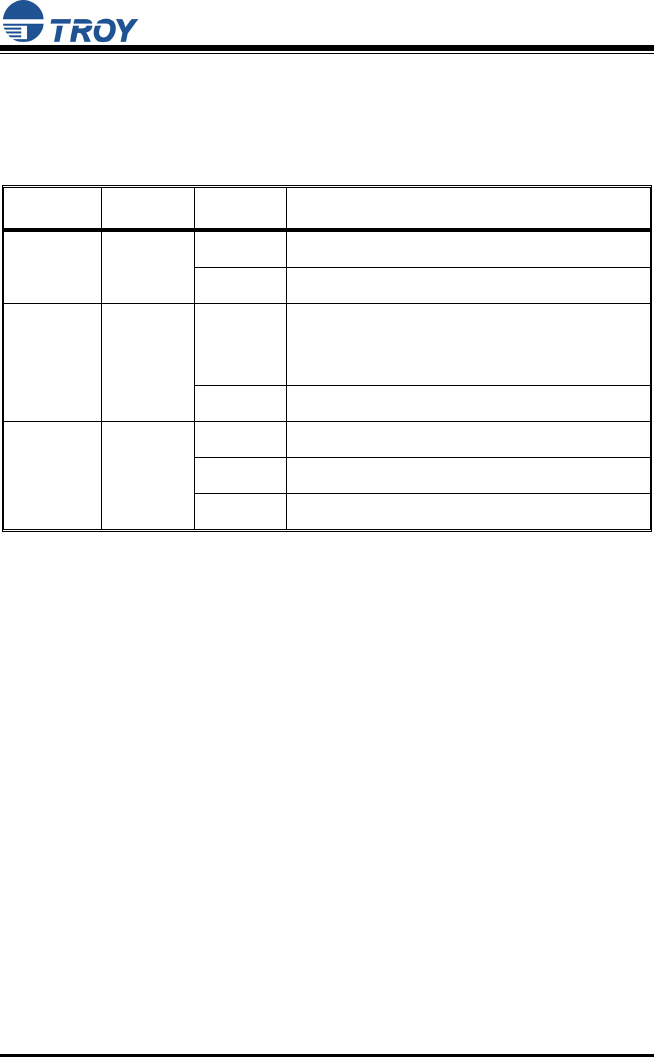
User’s Guide
Document #40177-100 Rev. X1 3
LED Status Indicators
The front panel of the EtherBridge adapter provides three LED (Light
Emitting Diode) indicators for easy monitoring. The following table
defines the function of each LED.
Label Color State Description
ON The device is receiving power.
PWR GREEN
OFF The device is not receiving power.
ON The device is associated to a wireless
access point and has wireless LAN
activity.
WLAN GREEN
OFF No wireless LAN activity.
Blinking Wired LAN activity.
OFF No wired LAN activity.
LAN GREEN
ON Ethernet link established.
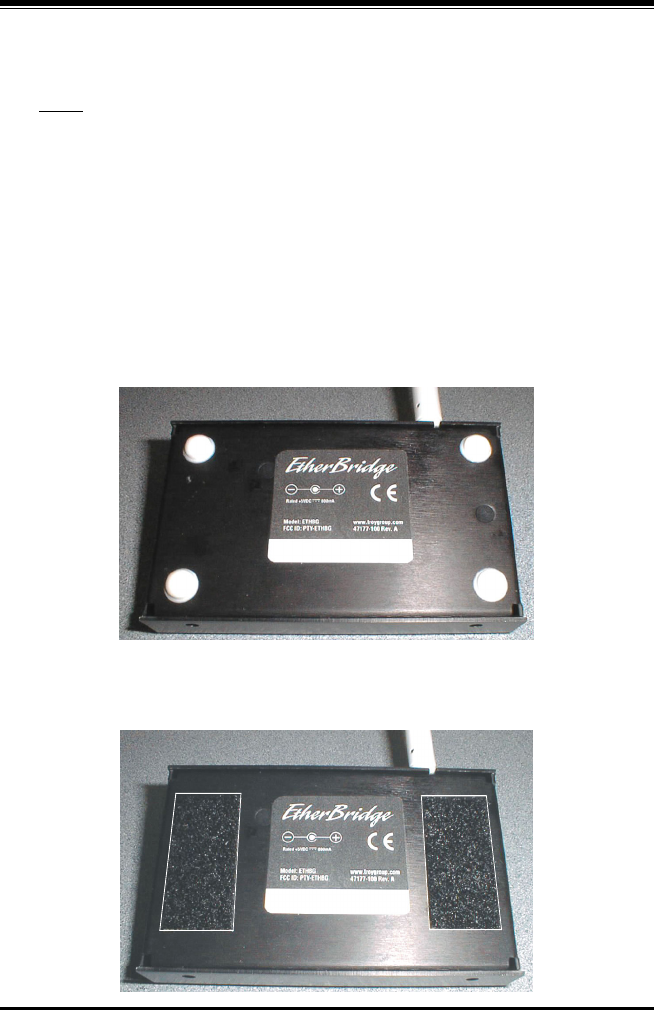
TROY Group, Inc.
4
Installing the EtherBridge Adapter Hardware
1. Connect the EtherBridge to any 10/100 Ethernet connection.
NOTE: Use the included Ethernet crossover cable when directly connecting two
devices together (such as a PC, printer, or other Ethernet-enabled device)
without the use of hub or switch.
2. Connect the power supply adapter to the power socket on the
EtherBridge adapter, and plug the other end of the power supply into
a suitable electrical outlet.
3. Mount the EtherBridge adapter on either the desktop or other
convenient location:
Desktop mount – attach the adhesive rubber feet (provided in
the desktop mounting kit) to the bottom of the EtherBridge
adapter as shown below.
Universal mount – peel off the protective backing from the
Velcro strips (provided in the universal mounting kit) and attach
one strip on each side of the product label as shown below.
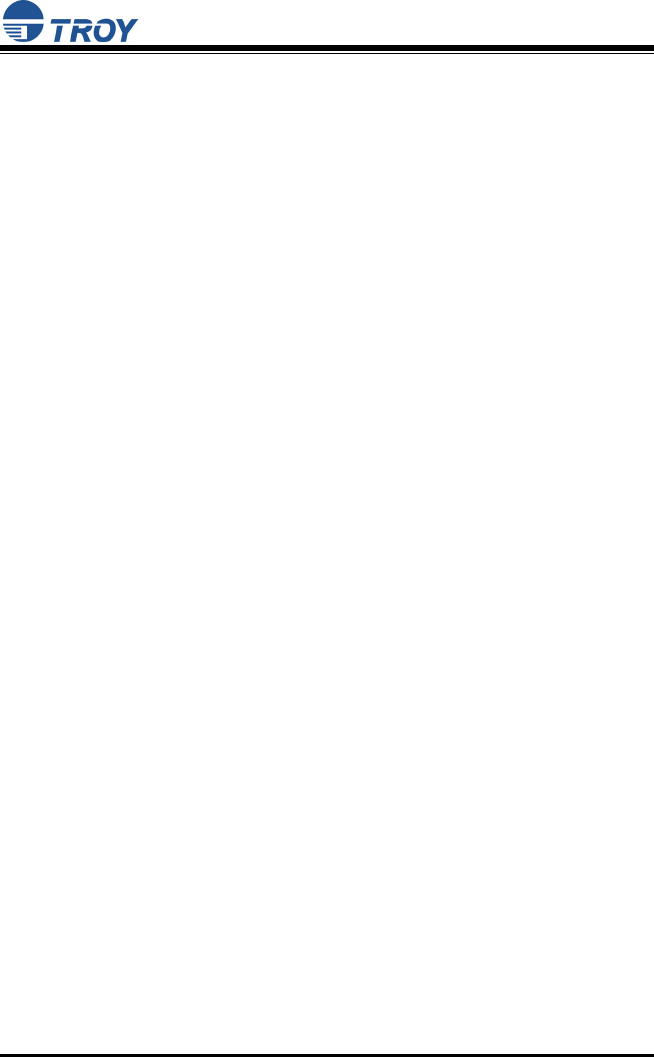
User’s Guide
Document #40177-100 Rev. X1 5
Configuring the EtherBridge Adapter
The EtherBridge adapter can be configured from either the EtherBridge
Configuration Utility (supplied on the TROY EtherBridge Installation CD
that came with the product and downloadable from www.troygroup.com),
or by using a standard Web browser (e.g., Internet Explorer or Netscape
Navigator).
Installing the EtherBridge Utility
1. Insert the EtherBridge Installation CD into the CD-ROM drive of your
Windows-based computer. The CD should start automatically on
any Windows 95 or later PC, and then display a top-level menu.
2. Click on EtherBridge Utility Setup, and follow the on-screen
instructions to install the EtherBridge Utility.
3. After the installation is complete, start the EtherBridge Utility from the
Windows Start menu (Start, Programs, TROY Group, EtherBridge,
EtherBridge Utility), and it will search for all available EtherBridge
adapters on the network.
4. Select the EtherBridge you want to configure. Enter the password
(the default password is access using all lower-case letters), and
then click on the Login button. You should now be able to configure
the EtherBridge.

TROY Group, Inc.
6
EtherBridge Utility Menus
The EtherBridge Utility provides five main menus (INFO, SECURITY,
STATUS, AP BROWSER, and ABOUT) to assist you with monitoring
and configuring the Etherbridge adapter. The following are brief
descriptions of each available menu.
Info
This menu item displays the current EtherBridge settings such as ESSID,
adapter name, rate, IP address, subnet mask, and default gateway.
ESSID
The ESSID is a unique ID used by access points and client stations
to identify a wireless LAN. Wireless clients associating to any
access point must have the same ESSID. The default ESSID is
“ANY”, which will connect the EtherBridge to the nearest access
point. The ESSID can have up to 32 characters.
NAME
Assign a unique name for the EtherBridge Adapter. The default
name is EtherBridge.
RATE
The EtherBridge provides various data rate options for you to select.
Data rates options include 1 Mbps, 2 Mbps, 5.5 Mbps, 11 Mbps,
and Auto. In most networking scenarios, the factory default “Auto”
setting will usually provide the most efficient data rate.
IP ADDRESS
Assign an IP address to your EtherBridge if you wish to configure it
via the Web Browser interface. Consult your network administrator
to obtain an available IP address (the default IP address is
192.168.1.1). For further setup, please refer to the following section.
SUBNET MASK
Assign a subnet mask to your EtherBridge if you wish to configure it
via the Web Browser interface. Consult your network administrator
to obtain the correct subnet mask to use.
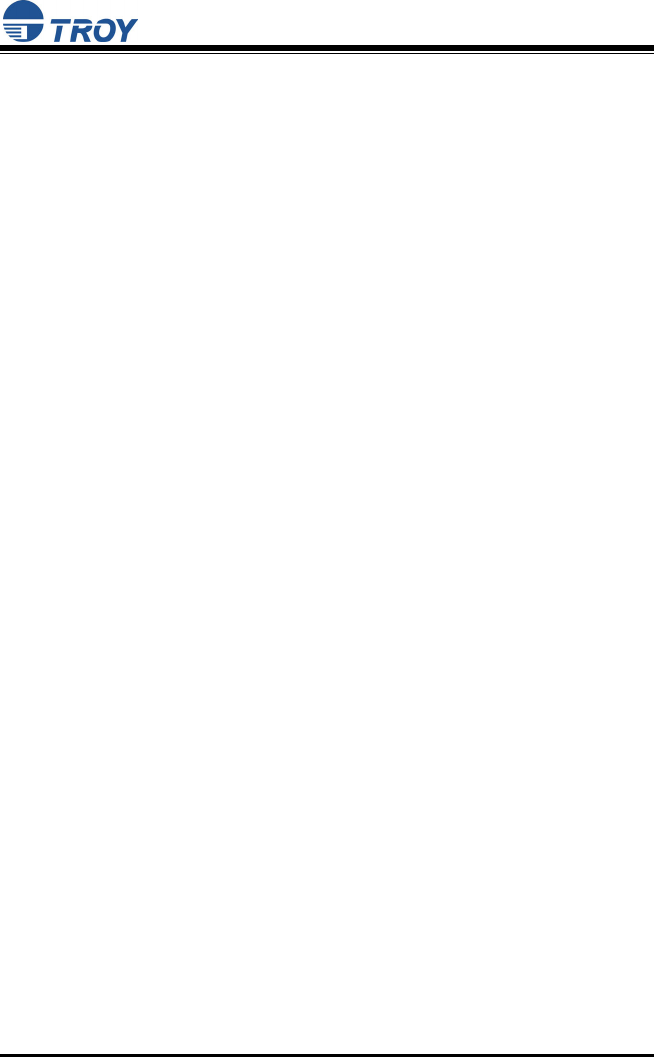
User’s Guide
Document #40177-100 Rev. X1 7
DEFAULT GATEWAY
Assign a default gateway to your EtherBridge if you wish to configure
it via the Web Browser interface. Consult your network administrator
to obtain the correct default gateway to use.
PASSWORD
It is highly recommended that you assign a new password to your
EtherBridge for security. Enter the new administrator password you
would like to use in the New Password and Confirm Password
fields respectively. Passwords are case-sensitive and are limited to
a maximum length of 32 alphanumeric characters.
After setting the parameters, click on the Apply button to save and
activate the changes. To return to the previous page, click on the
Cancel button.
DEFAULT
Click on the Default button to restore the EtherBridge to factory
default settings.
Security
To prevent unauthorized wireless stations from accessing data
transmitted over the network, the Wireless LAN Smart Station Adapter
offers WEP (Wired Equivalent Privacy), which encrypts data transmitted
over the wireless medium.
Click on the Security tab to view the current security status of the
EtherBridge. Click on the Setup button to change the current security
configuration.

TROY Group, Inc.
8
WEP
To enable WEP encryption, select the encryption type (either 40-bit
or 128-bit), and Key Format (ASCII, Hex, or Passphrase). Then
enter a WEP Key in the Edit Key field.
For 40-bit encryption you may choose the following:
ASCII: 5 characters (case sensitive) ranging from “a-z”, “A-Z” and
“0-9” (e.g., MyKey)
Hex: 10 hexadecimal digits in the range of “A-F”, “a-f” and “0-9”
(e.g., 11AA22BB33)
For 128-bit encryption you may choose the following:
ASCII: 13 characters (case sensitive) ranging from “a-z”, “A-Z” and
“0-9” (e.g., MyKey12345678)
Hex: 26 hexadecimal digits in the range of “A-F”, “a-f” and “0-9”
(e.g., 00112233445566778899AABBCC).
Create Encryption Keys Using a Passphrase
1. To create encryption keys by using a passphrase, select a key
format (either 40-bit or 128-bit).
2. Type a character string in the Passphrase field to generate the key
fields, and then click on Generate. As you type, the utility will
generate the four keys automatically.
3. Select one key from the Edit Key field, and then click on the Apply
button to save and activate the changes.
NOTE: Remember that the WEP key must match the WEP key of your wireless
access point.
After defining the WEP keys, click on the Apply button to save and
activate the changes.
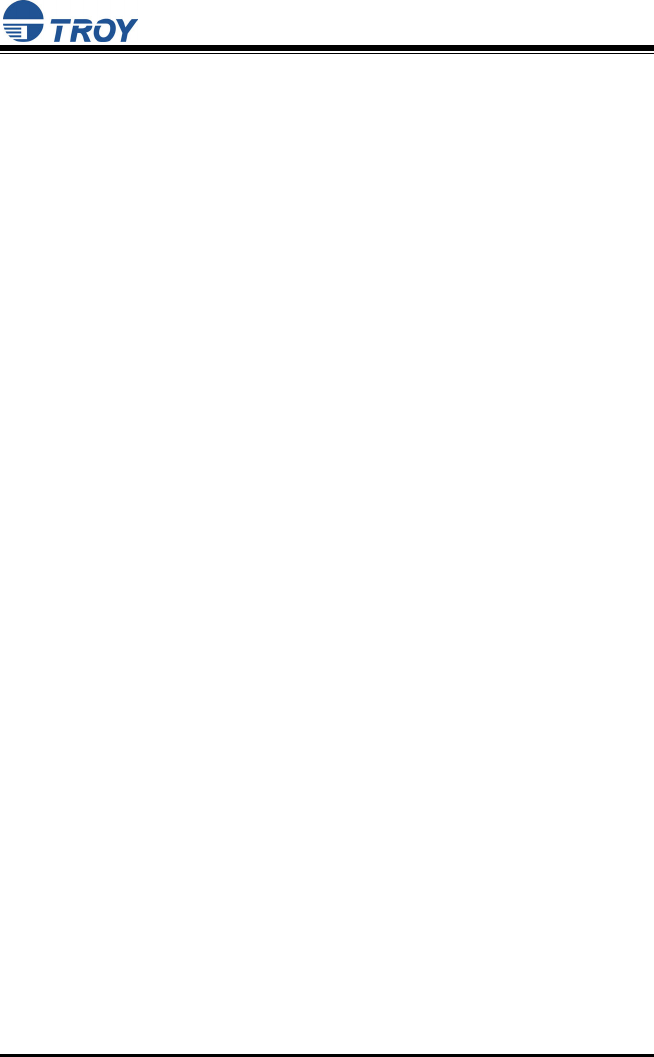
User’s Guide
Document #40177-100 Rev. X1 9
Status
The Status tab selection allows you to monitor the general information
regarding communications between the EtherBridge adapter and the
wireless access point.
AP Browser
By clicking the Refresh button, the AP Browser will reload and display
the available access points within range of the EtherBridge adapter.
Besides showing the BSSID of each access point, it also displays the
ESSID, channel, support, and capability. The AP Browser can have up
to 16 access points.
About
The About tab selection displays the version of the EtherBridge Utility
and the firmware version of the EtherBridge adapter.

TROY Group, Inc.
10
Web Browser Configuration
The Web Browser Interface allows the user to configure the EtherBridge
with a standard web browser such as Netscape Navigator or Microsoft
Internet Explorer. Therefore, any operating system that supports web
browser capabilities can be used to configure the EtherBridge adapter.
In order to use this feature, you must first make sure that you have a web
browser installed on your computer and that you have configured an IP
address in both the computer and the EtherBridge adapter.
NOTE: The EtherBridge and the computer need to be on the same TCP/IP subnet
(or both configured properly with the correct subnet mask and default
gateway if on a different subnet). For example, because the EtherBridge
default IP Address is 192.168.1.1, you would set your computer to have an
IP Address of 192.168.1.10.
Also, ensure that you have configured your computer’s web browser
properties to communicate over the local area network (rather than via a
PPP dial-up connection).
To use the Web Browser, start your web browser, and enter the default
IP address http://192.168.1.1 of the EtherBridge Adapter as the
destination web site. Once you are connected, enter the default
password access using all lower-case letters, and then select the item
that you wish to configure. You will then be connected to the appropriate
web page for configuration of that item. You may use the normal
browser buttons to move forward and backward through the web pages.
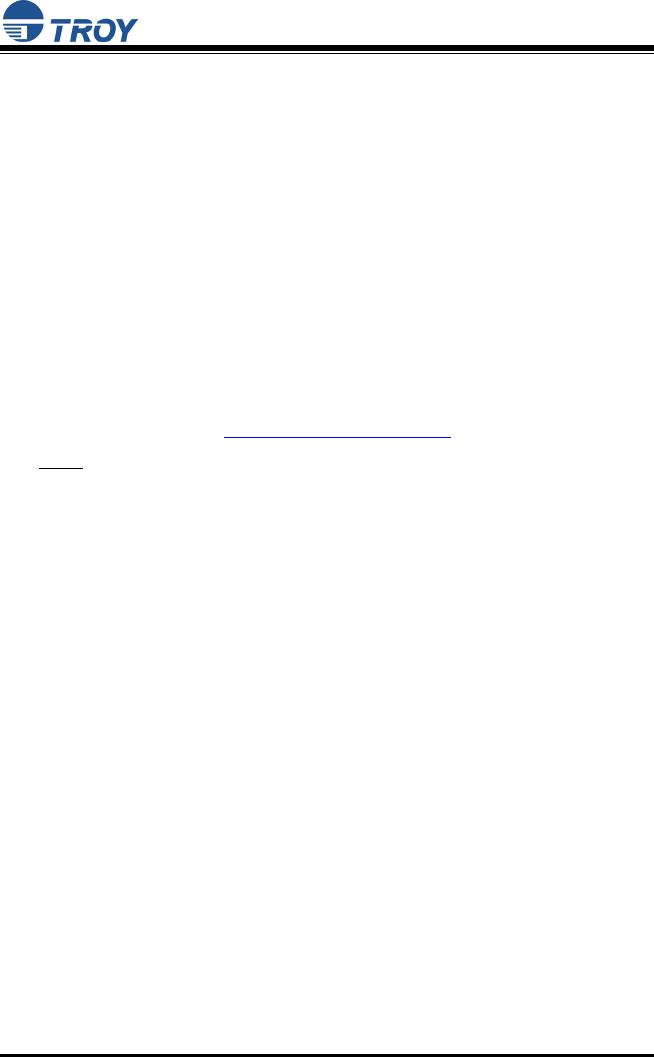
User’s Guide
Document #40177-100 Rev. X1 11
Upgrading the EtherBridge Firmware
The Firmware Upgrade Utility is included with the installation of the
Configuration Utility.
1. Start the Upgrade Utility by clicking on Start, Programs, TROY
Group, EtherBridge, Firmware Upgrade Utility. After the Upgrade
Utility starts, it will search for all available EtherBridge adapters on
the network.
2. Select the EtherBridge adapter you want to upgrade. Enter the
password (the default password is access using all lower-case
letters), and then click on the Login button.
3. Enter the firmware file name and path (folder or directory location) in
the file entry field (e.g., C:\downloads\ethbg20.bin) or browse for the
firmware file by clicking the Open File button. The latest firmware
files can be found at http://www.troygroup.com.
NOTE: Firmware upgrades are not normally needed. Only upgrade the firmware
if you are experiencing difficulties with the EtherBridge adapter or have
been advised to do so by a TROY Technical Support representative.
4. Click on the Upgrade button to automatically load the file into the
flash-file memory area of the EtherBridge adapter. When the
upgrade process is complete, the message “Upgrade successful”
will appear on the screen, and then the Upgrade Utility will return to
the main screen. The EtherBridge adapter is now ready for normal
operation.

TROY Group, Inc.
12
Obtaining Technical Support
TROY technical support is available to assist you with any questions
concerning the setup, operation, or maintenance of your TROY
EtherBridge adapter.
Worldwide Web Support
Located at http://www.troygroup.com/wireless, the TROY web site
provides answers to many common technical questions and also
includes copies of product manuals and literature, as well as utilities and
firmware load images.
Technical Support
North and South America
If you need to talk to one of our Technical Support Specialists, our
support line is open Monday through Friday, 8 AM to 8 PM, Eastern
Standard Time.
U.S. 48 contiguous States: (800) 332-6427
Canada, Alaska, Hawaii, and South America: +1-304-232-0899
E-Mail: technicalsupport@troygroup.com
Europe
Technical support is available in either German or English from Monday
through Thursday, 9 AM to 12 PM and 1 PM to 5 PM, and on Friday from
9 AM to 12 PM and 1 PM to 4 PM.
Phone: +49-7032-9454-21
E-Mail : support@troygroup.de
Web: http://www.troygroup.de
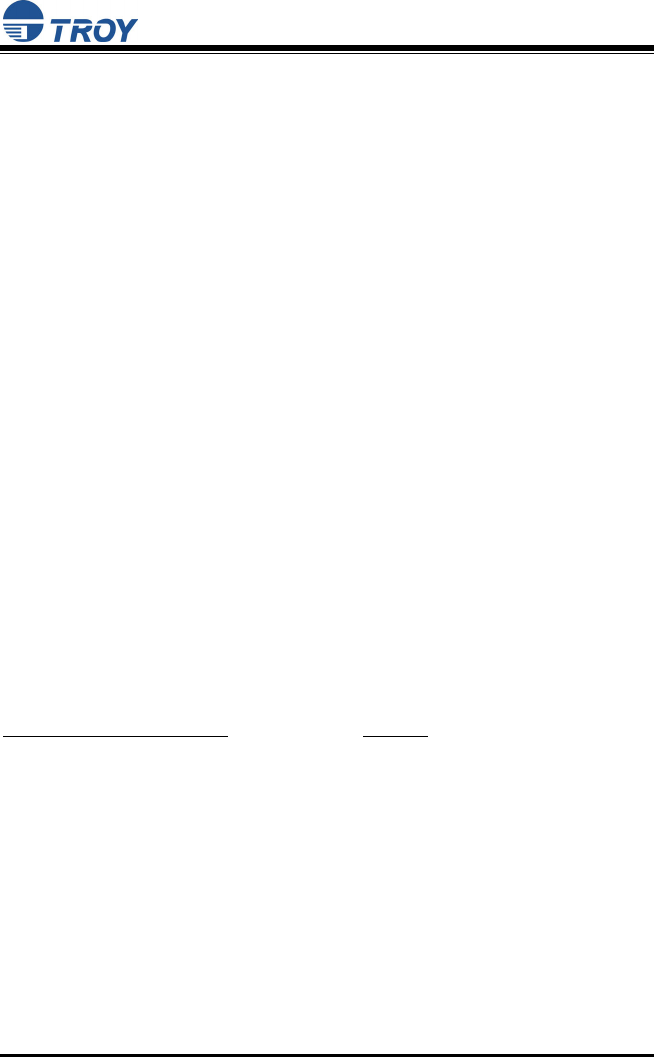
User’s Guide
Document #40177-100 Rev. X1 13
Returning Products
If you need to return a TROY product for any reason (failures, incorrect
shipments, etc.), follow the steps below:
1. Contact the TROY Technical Support group at (304) 232-0899 to
request a Return Goods Authorization (RGA) number (for North and
South American customers), or call +49-7032-9454-21 (for European
customers) and request a Return Material Authorization (RMA)
number.
2. Be prepared with the serial number of the unit you are returning.
You will be asked for the serial number to verify warranty coverage.
Please record these serial numbers in the space provided below for
future reference.
EthrBridge Model #: _________________________________
EtherBridge S/N: ____________________________________
Make sure that you write the RMA or RGA number on the outside of the
shipping container you use to return the product. Please ship the
defective product(s) to the appropriate address below:
North and South America: Europe:
TROY Group, Inc. TROY GmbH
RGA# _________ RMA# _________
3 Bryan Drive Schwarzwaldstr. 99
Wheeling, WV 26003 D-71083 Herrenberg,
Germany

TROY Group, Inc.
14
Contacts
Corporate Headquarters
TROY Group, Inc.
2331 South Pullman Street
Santa Ana, CA 92705 USA
(949) 250-3280
Technical Support
North and South America
U.S. 48 contiguous States: (800) 332-6427
Canada, Alaska, Hawaii, and South America: +1-304-232-0899
E-Mail: technicalsupport@troygroup.com
Europe
Phone: +49-7032-9454-21
E-Mail: support@troygroup.de
Web: http://www.troygroup.de
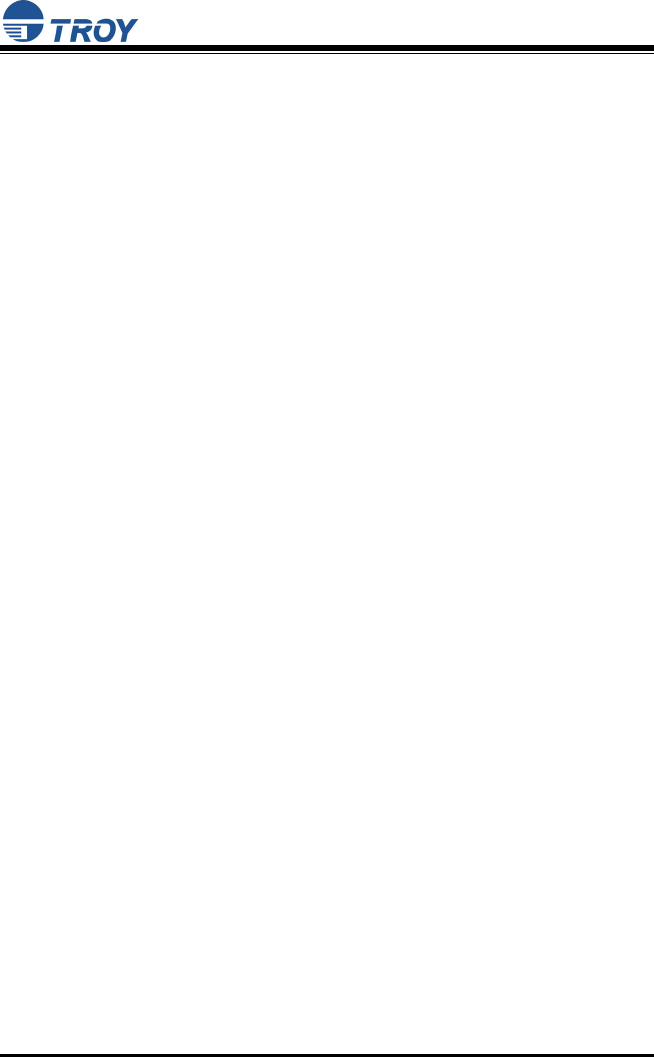
User’s Guide
Document #40177-100 Rev. X1 15
Safety and Regulatory Notices
FCC Compliance Statement (for United States Users)
This equipment has been tested and found to comply within the limits for
a Class B digital device pursuant to Part 15 of the FCC Rules. These
limits are designed to provide reasonable protection against harmful
interference in a residential installation. This equipment generates, uses,
and can radiate radio frequency energy and, if not installed and used in
accordance with the instructions, may cause harmful interference to
radio or television reception. However, there is no guarantee that
interference will not occur in a particular installation. If this equipment
does cause interference to radio and television reception, which can be
determined by turning the equipment off and on, the user is encouraged
to try to correct the interference by one or more of the following
measures:
Reorient or relocate the receiving antenna.
Increase the separation between the equipment and receiver,
Connect the equipment into an outlet on a circuit different from that
to which the receiver is connected.
Consult the dealer or an experienced radio/TV technician for help.
The radiated output power of EtherBridge is far below the FCC radio
frequency exposure limits. Nevertheless, the EtherBridge shall be used
in such a manner that the potential for human contact during normal
operation is minimized.
Warning
The connection of a non-shielded equipment interface cable to this
equipment will invalidate the FCC Certification of this device and may
cause interference levels which exceed the limits established by the FCC
for this equipment. It is the responsibility of the user to obtain and use a
shielded equipment interface cable with this device. If this equipment
has more than one interface connector, do not leave cables connected to
unused interfaces. Changes or modifications not expressly approved by
the manufacturer could void the user’s authority to operate the
equipment.

TROY Group, Inc.
16
FCC Compliance Statement (for European Users)
This product is in conformity with the protection requirements of EU
Council Directive 89/336/EEC on the approximation of the laws of the
Member States relating to electromagnetic compatibility. TROY Group
cannot be responsible for any failure to satisfy the protection
requirements resulting from a non-recommended modification of the
product.
This product has been tested and found to comply with the limits for
Class B Information Technology Equipment according to CISPR
22/European Standard EN55022. The limits for Class B equipment were
derived for typical residential environments to provide reasonable
protection against interference with licensed communications devices.
FCC Compliance Statement (for Canadian Users)
This Class B apparatus complies with Canadian ICES-003.
Cet appareil numérique de la class B est conforme à la norme NMB-003
du Canada.
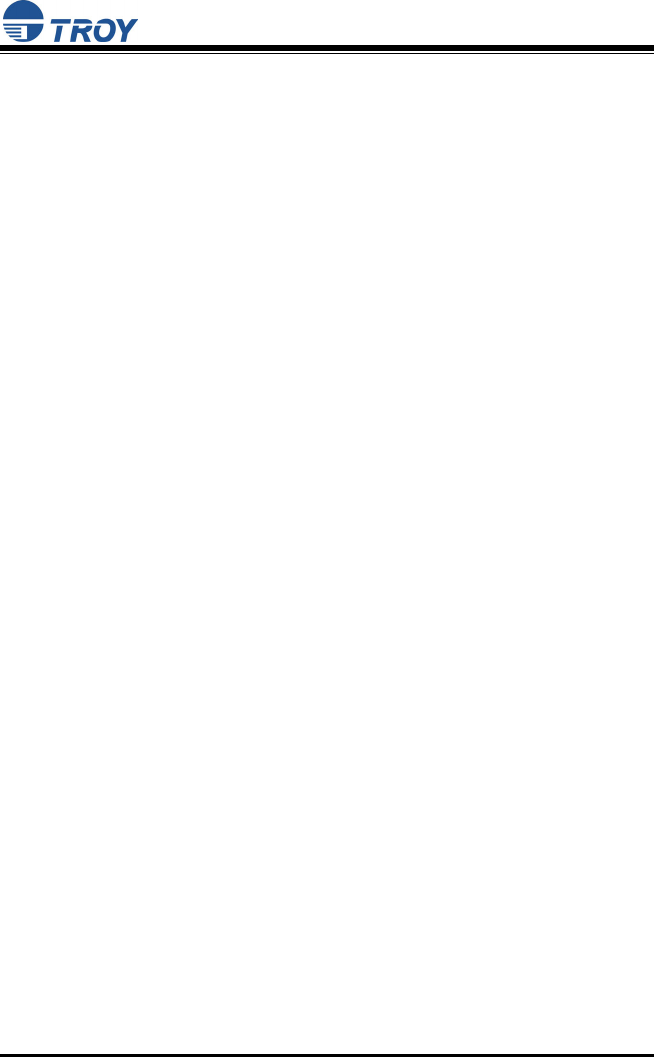
User’s Guide
Document #40177-100 Rev. X1 17
Declaration of Conformity
According to 47CFR, Part 2 and 15 for Class B Personal Computers and
Peripherals; and/or CPU Boards and Power Supplies used with Class B
Personal Computers:
We: TROY GROUP, INC.
Located at: 2331 South Pullman Street
Santa Ana, CA USA
Declare under sole responsibility that the product identified herein,
complies with 47CFR Part 2 and 15 of the FCC rules as a Class B digital
device. Each product marketed, is identical to the representative unit
tested and found to be compliant with the standards. Records
maintained continue to reflect the equipment being produced can be
expected to be within the variation accepted, due to quantity production
and testing on a statistical basis as required by 47CFR §2.909.
Operation is subject to the following two conditions: (1) this device may
not cause harmful interference, and (2) this device must accept any
interference received, including interference that may cause undesired
operation.
Trade Name: TROY
Type of Product: Ethernet to 802.11b Client Bridge
Model: EtherBridge

TROY Group, Inc.
18
Regulatory Information
To satisfy RF exposure requirements, this device and its antenna(s)
must operate with a separation distance of at least 20 cm from all
persons and must not be co-located or operating in conjunction with any
other antenna or transmitter. End-users must be provided with specific
operating instructions for satisfying RF exposure compliance.
European Union (EU)
TROY hereby declares that the 802.11b wireless technology built into
the EtherBridge is in compliance with the essential requirements and
other relevant provisions of European Directive 1999/5/EC. The internal
function is a radio device using the 2.4 GHz frequency band (2.400GHz
– 2.4835GHz). It is intended for wireless communication with other
802.11b-enabled devices. The internal 802.11b technology complies with
all applicable regulations FOR INDOOR USE in the following countries:
Austria, Belgium, Denmark, Finland, Greece, Germany, Iceland, Ireland,
Luxembourg, Norway, Portugal, Sweden,
The use of 802.11b wireless technology in other countries than those
listed above may be restricted: before using 802.11b products, please
confirm with the frequency management authority in the country where
you plan to use it. OUTDOOR USE REQUIRES A LICENSE IN MANY
COUNTRIES AND IS FORBIDDEN IN ITALY. In some situations or
environments, the use of 802.11b wireless technology might be restricted
by the proprietor of the building or responsible representatives of the
organization, for example onboard airplanes, in hospitals or in any other
environment where the risk of interference with other devices or services
is perceived or identified as harmful.
If you are uncertain of the policy that applies to the use in a specific
organization or environment, you are encouraged to ask for authorization
to use 802.11b wireless technology prior to switching it on. Consult your
physician or the manufacturer of personal medical devices (pacemakers,
hearing aids, etc.) regarding any restrictions on the use of 802.11b
wireless technology.
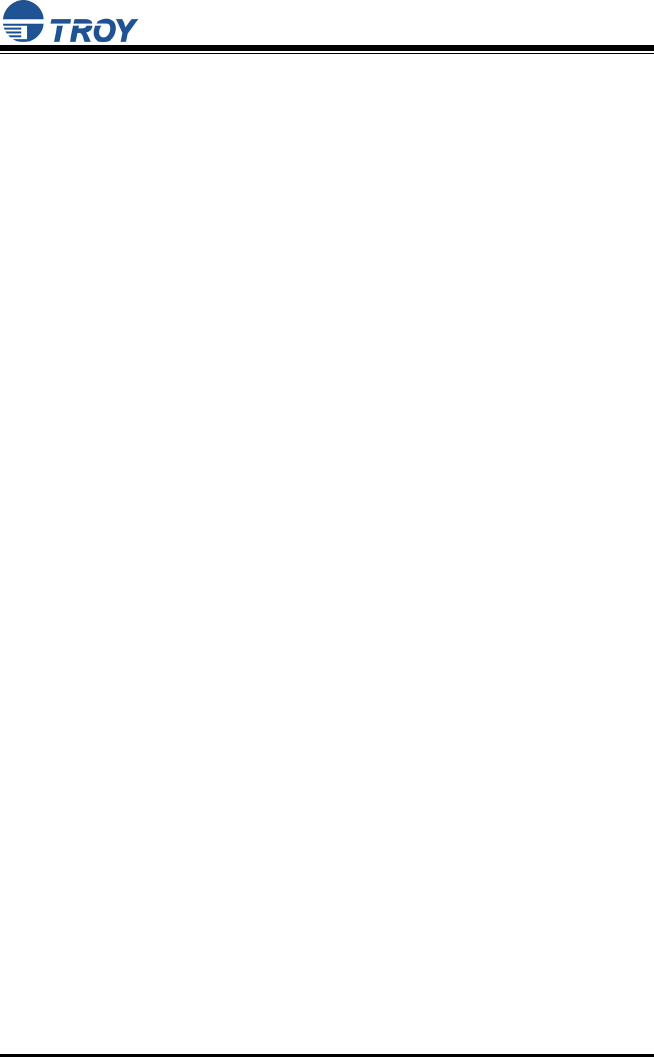
User’s Guide
Document #40177-100 Rev. X1 19
United States of America and Canada
Tested to Comply With FCC Standards FOR HOME OR OFFICE USE.
See FCC 47CFR, Part 15.19(b)(2).
This device complies with part 15 of the FCC rules and with RSS-210 /
RSS-139 of the Industry Canada.
Operation is subject to the following two conditions: (1) This device may
not cause harmful interference, and (2) this device must accept any
interference received, including interference that may cause undesired
operation.
Note that any changes or modifications to this equipment not expressly
approved by the manufacturer may void the FCC authorization to
operate this equipment.
Canada (IC notice)
To prevent radio interference to the licensed service, this device is
intended to be operated indoors and away from windows to provide
maximum shielding. Equipment that is installed outdoors is subject to
licensing.
Pour empêcher un brouillage radioèlectrique au service fasant l'object
d'une licence, cet appareil doit être utilisé à l'interieur et loin des fenêtres
afin de founir un écran de blindage maximal. Au cas aù un installation
en plain air, le materiel doit faire l'objet d'une licence.